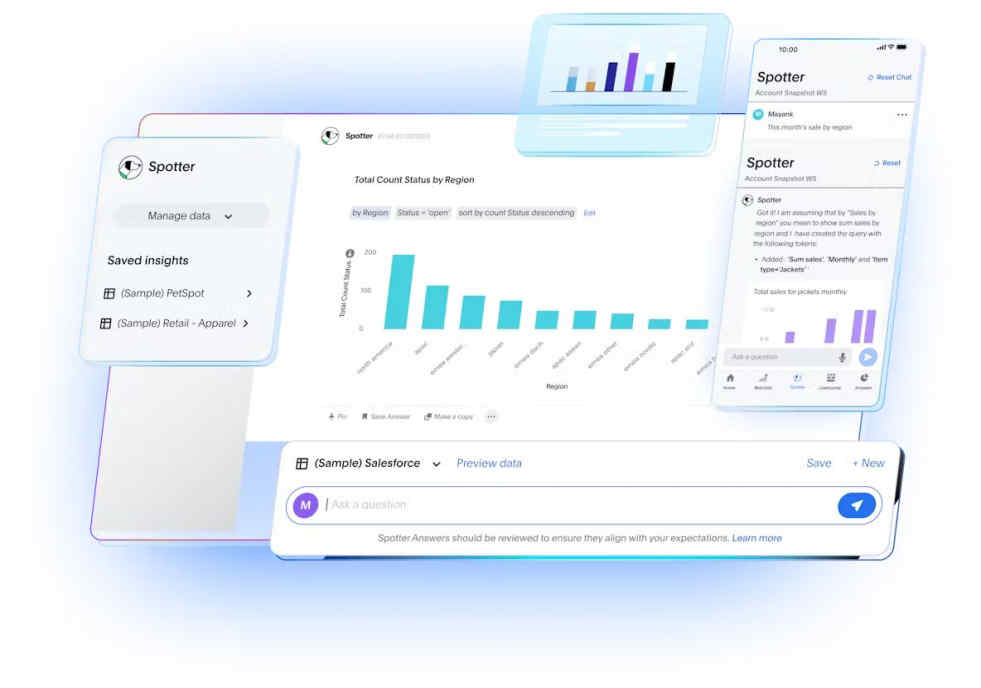 AI
AI
 AI
AI
 AI
AI
Business intelligence platform provider ThoughtSpot Inc. today announced that its Spotter conversational assistant now has reasoning capabilities that enable it to brainstorm and recommend courses of action.
Introduced last November, Spotter 3.0 has evolved beyond a query assistant to become “a research partner that can tell you what you need done in your business,” said ThoughtSpot Chief Executive Ketan Karkhanis.
In addition to operating as a front end for ThoughtSpot’s analytics engine, Spotter can now be embedded inside Salesforce Inc.’s customer relationship management and ServiceNow’s service management platforms.
ThoughtSpot’s core focus is on analyzing structured data. The new reasoning capabilities allow users to prompt with statements such as, “Tell me about this data set,” or “Why did sales drop from the third quarter to the fourth quarter?”
Karkhanis called these capabilities “change analysis,” meaning that the engine can understand the context of a question and explain why a trend or event is occurring. That’s in contrast to traditional BI dashboards, which display information but don’t explain what it means.
“I don’t think anybody wakes up in the morning and says they’re excited about building a dashboard,” he said. “Some of our customers have more than a hundred thousand dashboards that have accumulated over the years. We feel this is the new way of consuming analytics.”
ThoughtSpot said reasoning capabilities give the assistant the capacity to brainstorm and advise. “If you’re a new sales manager, you can ask it to help understand which products you should focus on,” Karkhanis said, “or if you see sales are going down, it will give you an explanation why.”
Users train Spotter through a process called “coaching” that involves asking questions and giving feedback. ”Spotter learns along the way and grows its capabilities,” Karkhanis said. “We have seen that coaching Spotter on roughly 10% of the questions you might ask trains it to answer 90% of the others.”
That’s in contrast to the retrieval-augmented generation technique used to customize large language models. “RAG doesn’t help you understand multiple paths to design certain queries and the speed of the analytics engine is not there,” Karkhanis said. Generative AI “doesn’t work well on structured data. It can’t handle 20 different tables with 120 different columns. You need an analytics engine for that.”
Spotter appears as a tab within Salesforce and learns from user queries. “Anybody can add Spotter to Salesforce with just one configuration change,” he said. “You never leave your Salesforce instance.”
ServiceNow users can access Spotter within existing workflows “because if you make a person go to the side to find data, they’re going to lose their chain of thought,” Karkhanis said. “We think of it as SalesSpot or ServiceSpot, it’s part of the workflow.” Additional integrations are planned.
ThoughtSpot works with multiple cloud data warehouses, including Google LLC’s BigQuery, Databricks Inc.’s Data Intelligence platform and Snowflake Inc.’s Data Cloud.
Spotter is LLM-independent and is the foundation for what Karkhanis said will be agentic capabilities in the future. “In the future you’ll be able to create agents that will not only monitor your data but also act on your behalf,” he said.
Support our mission to keep content open and free by engaging with theCUBE community. Join theCUBE’s Alumni Trust Network, where technology leaders connect, share intelligence and create opportunities.
Founded by tech visionaries John Furrier and Dave Vellante, SiliconANGLE Media has built a dynamic ecosystem of industry-leading digital media brands that reach 15+ million elite tech professionals. Our new proprietary theCUBE AI Video Cloud is breaking ground in audience interaction, leveraging theCUBEai.com neural network to help technology companies make data-driven decisions and stay at the forefront of industry conversations.